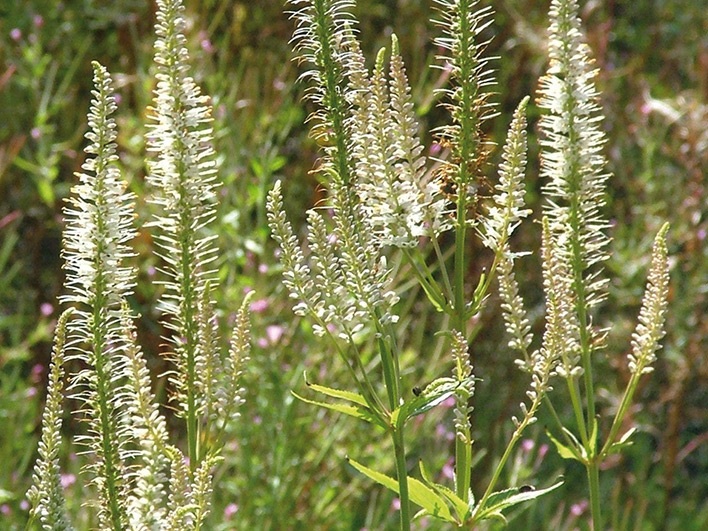Veronicastrum – Culver’s Root

This is one of my favourite plants for the garden or semi-wild areas. Generally flowering July to September it is very much loved by insects including butterflies. Tall, erect and imposing it is best for back of border planting. The upright stems are surrounded by whorls of leaves in a candelabra effect with the flower spike on top, sometimes branching, and in the cultivar ‘Fascination’ often fasciated i.e. distorted.
It prefers fertile soil which does not become too dry and will grow in sun or semi-shade. It can be slow to bulk up if divided in early Spring to grow on in pots, but does seed around mildly which may suit your requirements. The seedlings can be easily removed. It generally does not need staking. But if planting in a very exposed site it might be good insurance to do so.
V. virginicum was introduced from North America in the 1700s where it was widely used for its emetic and cathartic properties by a Doctor Culver who was a pioneer physician of the 18th century. V. sibiricum comes from Asia. Apparently the name Veronicastrum derives from St Veronica who gave Christ her veil to wipe his forehead while carrying the cross.
Veronicastrum virginicum ‘Album’ is a good form and if planted against a dark background its white flowers are a real stand out.
Veronicastrum v. ‘Apollo’ has almost blue flowers on a branched spike which slightly bends.
Veronicastrum v. ‘Erica’ is very similar to V.v. roseum, but differs in that it has red buds opening to pink flowers, as opposed to all pink.
Veronicastrum v. Fascination has lavender blue flowers, often on slightly fasciated spikes.
There are other forms of Veronicastrum e.g. latifolium which has broader leaves and V. sibiricum which is generally a shorter plant.
July Tips:
01. Feed all your garden plants in early July with a general purpose fertiliser. Feeding any later will encourage lush growth which may succumb to winter weather.
02. Keep dead-heading Cosmos & Sweet Peas to prolong flowering. Regularly pick runner beans.
03. Greenhouse Cherry Tomatoes — I usually wait until they are just starting to wilt before giving a good soak in the evening. I believe this concentrates the flavour as they are then not too watery when I come to pick them. Also I remove the side-shoots in the evening, never in the day, to help avoid white fly & aphid problems.
04. Ensure your greenhouse is very well-ventilated with all the vents & doors open. This encourages air movement & discourages fungal problems associated with humidity.
05. Cut back hardy geraniums, centaureas, nepeta (catmint) after flowering to encourage a second flush of flowers.
06. Cut back any extension growths on rambling or climbing roses if they are growing out of place. With sharpened secateurs, deadhead your roses regularly apart from those that produce notable hips later on in the season e.g. Rosa ‘Fru Dagmar Hastrup.’
07. Prune the long extension growths on wisteria back to four or six leaves from the main stem to encourage the plant to put more energy into producing flowers for next year rather than becoming a triffid!
Claire Jenkins (MCIHort)
Bordervale Plants, Ystradowen, Cowbridge, CF71 7SX
01446 774036
Back to Readers CornerWe know our patients read the Village Directory, their feedback tells us that many use it as a valuable reference point for all local services and phone numbers as well as a great monthly read. We have found it invaluable in ensuring our name is seen — Kathryn LowryDavies & Lowry Optometrists